Several decades ago, the tomato variety Druzhok was popular among both beginner and experienced gardeners. However, its popularity gradually declined due to reduced yields and pest infestations. Thanks to breeders, an F1 hybrid was developed based on this variety. Now, these tomatoes are more resistant to weather changes, protected from diseases, and delight with their excellent taste.
Table of contents
Description
The Druzhok F1 hybrid is determinate and medium-sized. The bush height does not exceed 50-70 cm. The foliage is compact and thick-stemmed, making it sturdy.
The first fruit cluster forms above the 6th leaf, with subsequent clusters appearing every 2-3 leaves. Each cluster produces 6 to 8 tomatoes.
Distinctive Features
The hybrid’s key feature is its low maintenance requirements, allowing fruit to ripen in any weather. After fruit formation on the main stem’s inflorescence, the plant enters an active growth phase—unusual for determinate tomatoes.
Note. To increase yield, bushes should be tied to a support.
When grown in unheated greenhouses or under polytunnels, the bush forms 2-3 stems. These develop from shoots in the leaf axils below the first inflorescence, resulting in 3-4 inflorescences per stem.
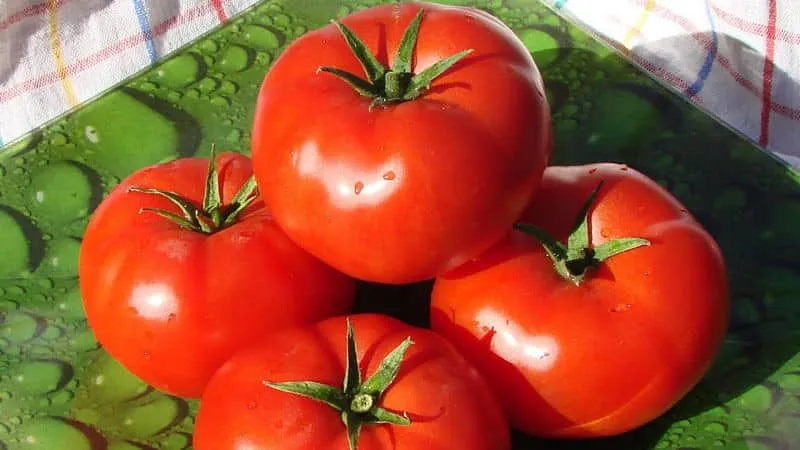
Fruit Characteristics and Yield
This hybrid is an early-ripening tomato, ready for harvest 85-90 days after germination. The fruits ripen almost simultaneously, making harvesting efficient—ideal for processing or sale. Germination rates reach 90%. A photo of ripe Druzhok tomatoes is shown above.
High yield: 8-10 kg per m². The hybrid tolerates transport and long storage without losing appearance or taste. It withstands temperature fluctuations and direct sunlight while responding well to fertilisation and watering.
Fruit characteristics:
- Vibrant red colour.
- Flat-round shape.
- Average weight: 110-115 g.
- With optimal care, fruits can reach 150-200 g.
- Sweet, meaty, and firm texture.
- Seeds are located in 2-4 chambers.
- When processed into juice, dry matter content is at least 5%, sugar—4%.
These tomatoes are suitable for fresh consumption, canning, and processing. Their attractive appearance makes them popular among market gardeners.
How to Grow Seedlings
According to the packaging instructions, seeds should be sown between April 1-15. If planting is planned for late May or early June, adjust the sowing to April 15-30.
Seed Preparation
To protect against fungal diseases and improve germination, treat seeds with a potassium permanganate solution (1 g in 100 ml of room-temperature water).
The solution should be dark and thick—ensuring proper disinfection. Soak seeds for 25 minutes. If the packaging states they are pre-treated, skip this step.
Important! Before planting, check seed quality by soaking them for 30 minutes. Floating seeds are unusable. Also, verify the expiry date on the package.
Rinse the seeds under running water and dry with a paper towel. Use a growth stimulant if desired. Soak a piece of gauze in the solution, place the seeds inside, and leave in a warm place for 24 hours. Recommended products: "Epibrassinolide," "RootBoost," "BioSil," or sodium humate.
Containers and Soil
Use seedling trays available at garden centres or DIY shallow, wide containers. Transplant seedlings into 300 ml pots. Suitable containers are shown below.
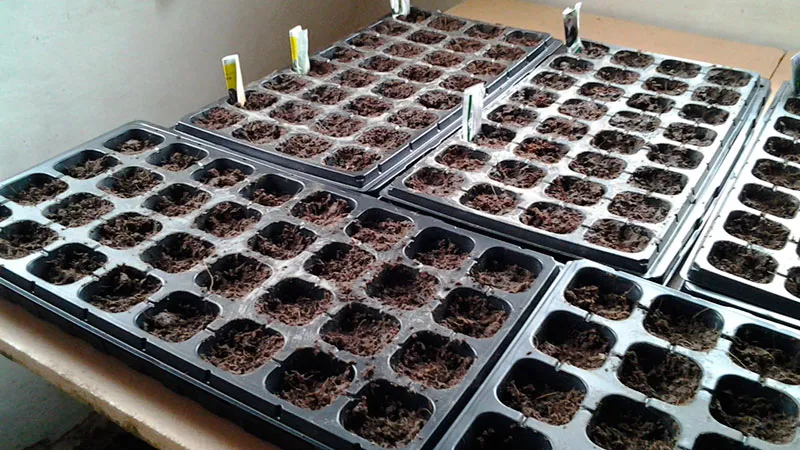
Prepare soil using humus and black earth. For better texture, add sand, sawdust, or fine coconut fibre. Optionally, include ash and "BioFungicide." Ready-made mixes for tomatoes and peppers are also suitable.
Tip. Experienced gardeners recommend using greenhouse soil for easier adaptation after transplanting.
Outdoor soil may contain pests. Disinfect by baking in an oven, pouring boiling water, or treating with potassium permanganate solution (30 minutes).
Sowing
Make 1-2 cm deep holes or furrows, spaced 2 cm apart. Place seeds inside, cover lightly with soil, and mist with warm water.
Cover containers with film or glass and keep at 23-25°C. Germination typically occurs within 3-5 days.
Growing and Care
After sprouting, maintain daytime temperatures at 16-18°C and nighttime at 13-15°C until 2-3 true leaves appear (~30-35 days). Water sparingly—2-3 times total—to prevent elongation in low light.
Rotate trays daily for even growth. Avoid wetting leaves. Seedlings do not need fertiliser at this stage. Transplant into 8×8 cm pots after 2-3 leaves form and grow for another 20-25 days.
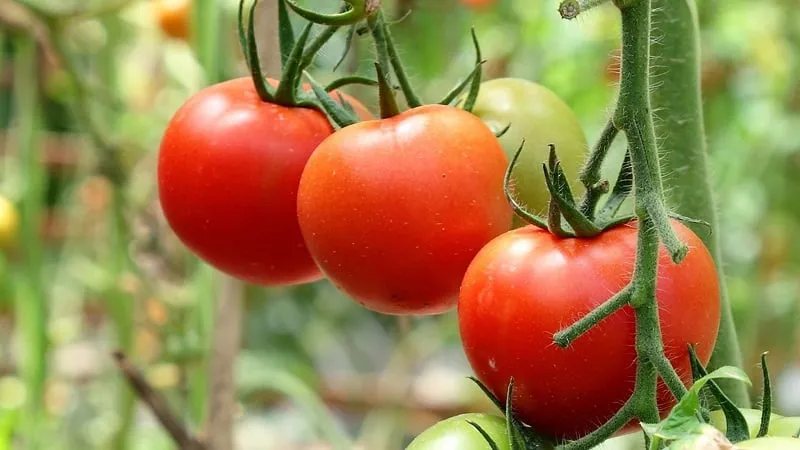
How to Grow Tomatoes
Soil quality is crucial. For clay-heavy soil, add 1 bucket of peat, humus, or sawdust per m². For peat-rich soil, mix in humus, turf, or sand.
Planting
Transplant seedlings at 30-35 days old, typically in late May or early June. For outdoor planting, delay sowing by 2 weeks to ensure stable temperatures.
Disinfect soil with hot potassium permanganate solution (1 g per 10 L water). Space plants 40-50 cm apart in rows or staggered.
Care
Water regularly—maintain 85-90% soil moisture and 50% air humidity. After transplanting, water deeply at the base and wait 2-3 days before resuming 1-2 weekly waterings.
Note: During flowering, ensure magnesium supplementation.
Fertilise every 2-3 weeks, alternating organic and mineral options. Combine weeding with inter-row loosening (≤12 cm deep initially). Hill plants 2-3 weeks after transplanting, repeating every 15 days.
Growing Challenges
Expert recommendations:
- Feed young seedlings with liquid fertilisers.
- Treat roots with strengthening solutions before transplanting.
- Select only strong seeds and seedlings.
- Use drip irrigation or water individually at the base.
- Mulch with straw, hay, or fresh grass.
This hardy hybrid faces few challenges if planting and care guidelines are followed.
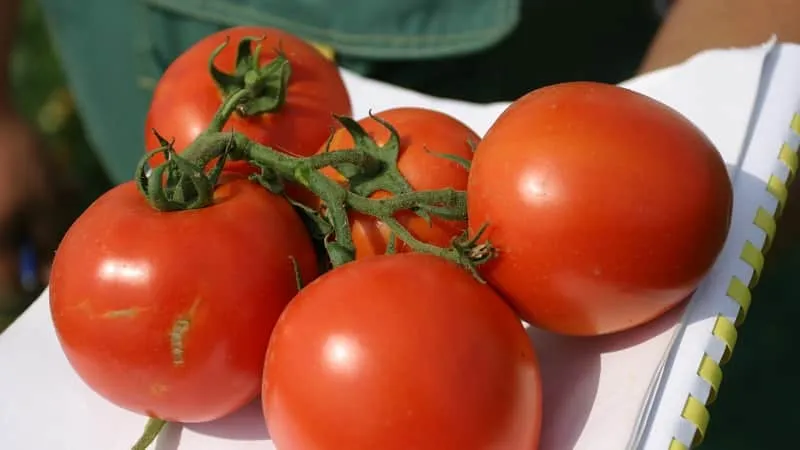
Pests and Diseases
The hybrid was bred for resilience. Its stems and leaves contain alkaloids that deter pests.
For prevention, inspect plants regularly. Spray with soap solution (1 tbsp grated soap per 10 L water) if needed.
Growing in Open Ground vs. Greenhouses
As a determinate variety, growth stops after 3-4 inflorescences. In greenhouses, grow as a single stem.
Tip. Single-stem growth allows 25-30% higher planting density.
Pinch the growing tip after 3-4 inflorescences. Remove side shoots once they develop 3-4 clusters to direct energy to the main stem. Repeat until plants reach the greenhouse roof or maximum height.
For outdoor planting, use 3 stems. Leave shoots below the first inflorescence to develop strong side stems, creating a 1 m bush with 3-4 inflorescences per stem.
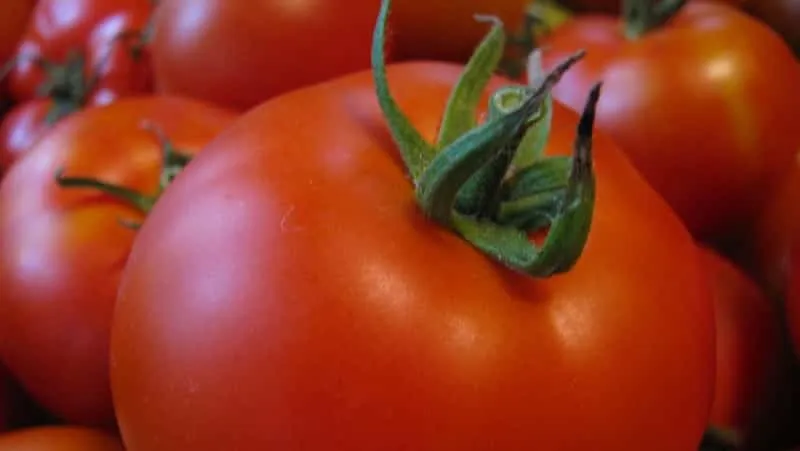
Harvesting and Uses
Harvest 85-90 days after germination, in 1-2 sessions. These versatile tomatoes are ideal for fresh eating, cooking, canning, and processing.
Pros and Cons
Advantages:
- Fast ripening.
- High yield.
- Suitable for unheated greenhouses.
- Excellent flavour.
- Versatile use.
- Marketable appearance.
Disadvantage: Requires staking, which is time-consuming.
Grower Reviews
Feedback is overwhelmingly positive.
Sophie, France: “I grew this hybrid last year with great results. Learning stem formation techniques was key. Now I’ll plan support structures in advance. The only downside is not being able to save seeds.”
Anna, Germany: “I cultivated these in patio pots. With three stems, the bush became beautifully sprawling. The tomatoes were delicious—even kids loved them. Highly recommended!”
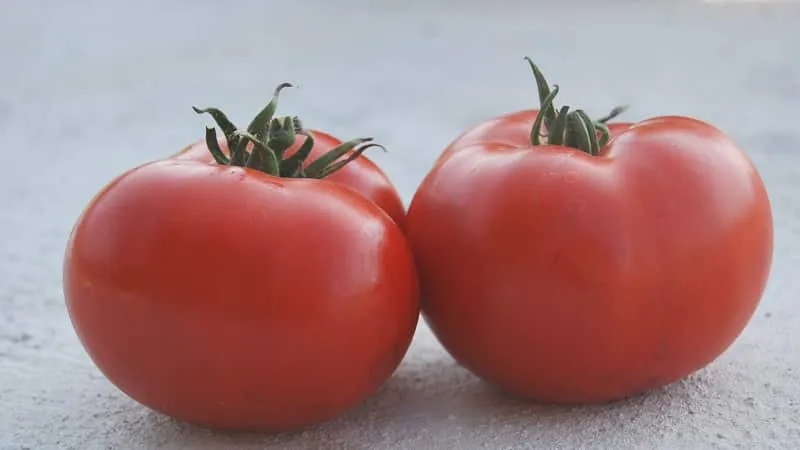
Conclusion
The Druzhok F1 hybrid delivers abundant, flavourful tomatoes in one season—enough for family use and sales. Its low-maintenance nature, resilience to weather and pests, and adaptability make it a gardener’s favourite.







